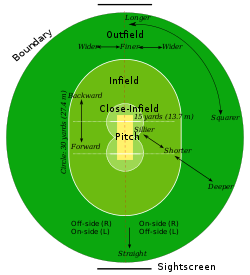Summary
A cricket match is played between two teams of eleven players each[19][20] on a grassy field, typically 137–150 metres (150–160 yd) in diameter.[21] The Laws of Cricket do not specify the size or shape of the field[22] but it is often oval.
A cricket match is divided into periods called innings. During an innings (innings ends with 's' in both singular and plural form), one team plays defense (the fielding team) and the other offense (the batting team). The two teams switch between fielding and batting after each innings. All eleven members of the fielding team take the field, but only two members of the batting team (two batsmen) are on the field at any given time.
The key action takes place in the pitch, a rectangular strip in the centre of the field. The two batsmen face each other at opposite ends of the pitch. The fielding team's eleven members stand outside the pitch, spread out across the field.
Behind each batsman is a target called a wicket. One designated member of the fielding team, called the bowler, is given a ball, and attempts to throw (bowl) the ball from one end of the pitch to the wicket behind the batsman on the other side of the pitch. The batsman tries to prevent the ball from hitting the wicket by striking the ball with a bat. If the bowler succeeds in hitting the wicket, or if the ball, after being struck by the batsman, is caught by the fielding team before it touches the ground, the batsman is dismissed. A dismissed batsman must leave the field, to be replaced by another batsman from the batting team.
If the batsman is successful in striking the ball and the ball isn't caught before it hits the ground, the two batsmen may then try to score points (runs) for their team by running across the pitch, switching positions. Each switch of positions is worth one run. The batsmen may attempt multiple runs or they may attempt no runs. By attempting runs, the batsmen risk dismissal, which can happen if the fielding team retrieves the ball and hits a wicket with the ball before a batsman has reached that end of the pitch.
If the batsman hits the bowled ball over the field boundary without the ball touching the field, the batting team scores six runs and may not attempt more. If the ball touches the ground and then reaches the boundary, the batting team scores four runs and may not attempt more. When the batsmen have finished attempting their runs, the ball is returned to the bowler to be bowled again. The bowler continues to bowl toward the same wicket, regardless of any switch of the batsmen's positions.[23]
After a bowler has bowled six times (an over), another member of the fielding team is designated as the new bowler. The new bowler bowls to the opposite wicket, and play continues. Fielding team members may bowl multiple times during an innings, but may not bowl two overs in succession.
The innings is complete when 10 of the 11 members of the batting team have been dismissed or a set number of overs has been played. The number of innings and the number of overs per innings vary depending on the match.

No comments:
Post a Comment